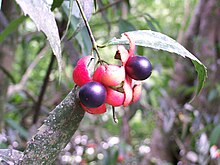Hennecartia omphalandra
| Hennecartia omphalandra | ||||||||||||
|---|---|---|---|---|---|---|---|---|---|---|---|---|
| Systematics | ||||||||||||
|
||||||||||||
| Scientific name of the genus | ||||||||||||
| Hennecartia | ||||||||||||
| J. Poiss. | ||||||||||||
| Scientific name of the species | ||||||||||||
| Hennecartia omphalandra | ||||||||||||
| J. Poiss. |
Hennecartia omphalandra is a tree in the Monimia family from southeastern Brazil , Paraguay, and northeastern Argentina . It is the only species in the genus Hennecartia .
description
Hennecartia omphalandra grows as a smaller, evergreen and slow-growing tree up to about 10 meters high. The trunk diameter reaches up to 35 centimeters. The brown bark is rough and slightly cracked, finely furrowed and flakes off in small plates with age.
The simple, short-stalked, leathery and almost bare leaves are arranged opposite or often whorled. The slightly hairy, short petiole is up to 1 centimeter long. The elliptical, lanceolate or obscure-lanceolate leaves are completely to serrate or pointed, glandular-toothed and 6–13 centimeters long and 2–3.5 centimeters wide. At the top they are pointed to pointed, pointed or, less often, indented.
Hennecartia omphalandra is dioecious diocesan . The flowers appear on small bracts . The male flowers are usually terminal, racemose arranged inflorescences with a few flowers. The female flowers are stalked and appear axillary, opposite or whorled with a few flowers. The male, stalked and disc-shaped flowers are almost without an inflorescence and with many (40-60), seated, dome, mushroom-shaped and round to angular, yellow stamens which are arranged on the disc-shaped, green flower base . The anthers open with a central slit. The female flowers have a simple flower envelope made of 4 very small tepals on a green, urn-shaped, hairy outside and almost closed, fleshy, leathery flower base and 1–2 carpels below . At the small opening at the tip (ostiole) sit four fleshy, large nectar glands that close it ( hyperstigma ). Here pollination does not take place directly on the scar, but on the upstream and slimy plug, at the "mouth" of the narrowed flower cup, which here completely encloses the carpels.
There are round and black, smooth, shiny, about 1.2 to 1.8 centimeters, seeded drupes in a fleshy, outside initially brownish scabby, green and later red inside, about 2.5 centimeters wide, rounded to pear-shaped Flower base formed ( false fruit ). When it is ripe, the fleshy, surrounding flower base then rips open irregularly. The flesh is thin and the large, smooth stone core is brownish and ellipsoidal.
literature
- K. Kubitzki , Jens G. Rohwer , Volker Bittrich: The Families and Genera of Vascular Plants. Vol. II: Flowering Plants Dicotyledons , Springer, 1993, ISBN 978-3-642-08141-5 (Reprint), pp. 426, 428 f, 436.
- Harri Lorenzi: Árvores Brasileiras. Vol. 3, Instituto Plantarum, 2009, 2011, ISBN 85-86714-33-7 , p. 215, online at StuDocu.
- AL Peixoto: Monimiaceae. In: MGL Wanderley, GL Shepherd, AM Giulietti, TS Melhem, V. Bittrich, C. Kameyama: Flora Fanerogâmica do Estado de São Paulo. Vol. 2, FAPESP, 2002, ISBN 85-7523-053-0 (online), pp. 189-208, online (PDF; 2.8 MB).
Web links
- Hennecartia omphalandra at Useful Tropical Plants.
- Hennecartia omphalandra at UFRGS, Universidade Federal do Rio Grande do Sul (images).
